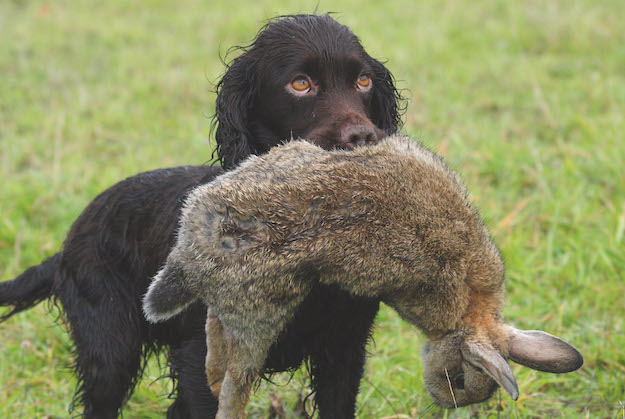What size is the perfect gundog?
Bigger isn't necessarily better when it comes to the perfect gundog, says David Tomlinson

Small dog, big retrieve. A cocker spaniel with a fairly hefty rabbit
OK, I admit it. I have always been a fan of big, old-fashioned springers, chunky cockers and Labradors with substance, but I’m beginning to think that gundog size doesn’t really matter after all. When it comes to performance, small dogs can perform as well as, and sometimes better than, bigger, more powerful animals.
I have a friend, Peter, who has owned and worked English springers for more than 50 years. Ask him which was his best dog and he will say Polly. Now, Polly was an English springer he bred himself, but she was the runt of the litter. She was sold to what should have been a good working home, but was returned after a few weeks as her new owner decided that she would never make the grade as a proper gundog. It wasn’t an auspicious start to her shooting career.
Polly never did grow, becoming a miniature springer and rather smaller than most cockers. Fortunately, this didn’t put Peter off, so she received the same training, the same discipline, as all his other spaniels. He discovered that Polly was a very determined little dog and there was nothing that fazed her.
She proved to be highly trainable, becoming a rock-steady peg dog, with no need for a lead, and a talented and intuitive picking-up dog with the happy knack of finding the birds that no other dogs could locate. She may have weighed a mere 10kg, but was quite capable of picking the biggest cock pheasant without any trouble.
Polly was unregistered, so she never competed in field trials, but her moment of glory came at the Game Fair at Blenheim in 2011, when she won the first CLA working gundog test for any breed that hadn’t had a first, second or third in a field trial. On that day, she beat many bigger, more powerful dogs. It was a fitting recognition of her remarkable ability, achieved despite her lack of gundog size.

Polly the mini springer retrieving a cock pheasant
Gundog size
I think of Polly often as my sprocker, Emma, is similar in looks, build and size, not to mention determination. When I decided to get a sprocker, I assumed that my puppy would eventually be the size of a big cocker or small springer. However, Emma failed to grow, despite being fed a top-quality diet. Coming up for three, she weighs a fraction less than 11kg and is invariably mistaken for a puppy.
The advantages of small dogs
Emma has demonstrated to me the advantages of small dogs. Most of the benefits are obvious, but I had never really considered them all before. Small dogs take up small spaces. For transport, you don’t need a Range Rover or pickup truck. You could fit three Emmas into the back of a Fiesta. They don’t need full-size dog beds, a modest cost saving, as there is when you come to buy wormers.
One major plus point is that it’s so easy to pick up a small dog. Whether it’s popping it over a barbed-wire fence or lifting it on to the vet’s table, it’s so much easier than with a full-size, 20kg springer, let alone a 30kg Labrador. A small dog also has considerably less surface area, so it’s quicker and easier to clean it off after a day in the field — and it will bring less grit and mud into the house.
Feeding time
There should be a bonus, too, when it comes to feeding, but while a small spaniel won’t eat anything like as much as a large Labrador, my experience suggests that small spaniels require almost the same amount of food as a larger one. Emma eats the same as my springer, Rowan, aged 14, though a young dog requires a lot more energy than an old one.
Another curious fact is that small dogs live, on average, longer than big dogs. Whether this means you will get an extra season or two’s work out of a cocker than you would from a Labrador is debatable, but small dogs seem to be less prone to the sort of muscular injuries that bigger animals so often suffer.
Six rules for caring for your gundog after a shoot day
Tony looks at ways of keeping a hard-working gun dog happy during the season.
There are disadvantages. Wildfowlers need a strong, powerful swimmer, capable of picking a hefty old greylag gander. That is beyond most springers, let alone anything smaller. Big dogs also retain heat more efficiently than small dogs, important if it will need to sit for hours in a hide. I’ve seen cockers struggle to retrieve hares, hardly surprising as a big hare can weigh 6kg or 7kg. If you do a lot of hare shooting then a retriever is sure to be your most effective companion. However, not many of us shoot hares or geese. For most of us, small gundog size makes sense. There’s even a case for having two cockers rather than one Labrador. Food for thought.









